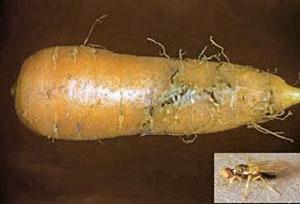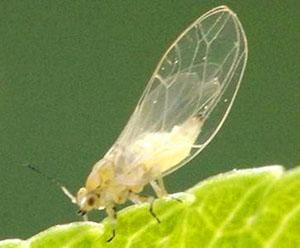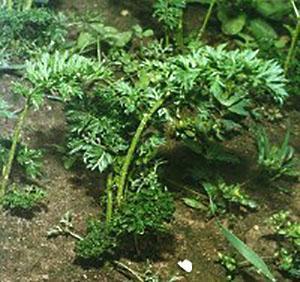Carrot pests
 A delicious vitamin vegetable is liked not only by humans. Carrots love various insects and other animals. By feeding on plant sap, they harm the fruit. To be able to preserve the harvest, you need to know the enemy by sight and be able to deal with it.
A delicious vitamin vegetable is liked not only by humans. Carrots love various insects and other animals. By feeding on plant sap, they harm the fruit. To be able to preserve the harvest, you need to know the enemy by sight and be able to deal with it.
Carrot lily

The plantings located near conifers are striking. Conifers are an intermediate host, they also accumulate in the planting of wild carrots, and with the emergence of seedlings of sowing carrots, it switches to them.  Both larvae and adult insects suck out the sap, which greatly oppresses the plants. The leaves curl, outwardly become similar to curly varieties of parsley.
Both larvae and adult insects suck out the sap, which greatly oppresses the plants. The leaves curl, outwardly become similar to curly varieties of parsley.
Prevention: spatial isolation.
Control measures: insecticide treatment in May or June. Usually one treatment is sufficient.
Carrot fly
 Perhaps the most common pest in carrots. The abdomen is black with a slight greenish tint, the head is brown, the legs and whiskers are yellow, the length of the imago is up to 0.5 cm. The larvae are yellowish, up to 7 mm, the puparia (pseudococonae) are brown.
Perhaps the most common pest in carrots. The abdomen is black with a slight greenish tint, the head is brown, the legs and whiskers are yellow, the length of the imago is up to 0.5 cm. The larvae are yellowish, up to 7 mm, the puparia (pseudococonae) are brown.
An adult insect lays up to 120 eggs near the root crop or on its surface. The larvae that come out bite into the root crop, where they feed for about a month. Puparia form in the soil, sometimes in the root crop. Usually, two generations over the summer, puparia hibernate in the ground or in root crops in storage.
Loves wet, shaded places. Infection of crops can be easily identified by a change in the color of the leaves, which acquire a red-purple hue.
Prevention:
- Early and winter sowing - will reduce harm, since the most dangerous is the defeat of young plants.
- Avoidance of thickened and buried crops.
- Alternating rows of carrots with onions, cilantro, dropping green tops of a tomato, sprinkling the aisles with tobacco, mothballs - foreign odors reduce the degree of damage, masking carrots.
- Digging deep.
Control measures:
- Spraying with insecticides. And it happens several times over the summer, as needed.
- Removal of infected root crops.
Carrot aphid
 Light green wingless and slightly darker winged small insects. Several generations are hatched over the summer. Eggs overwinter, the first generations are wingless, later on - winged. They suck out the juice, and in an amount much larger than is needed for food: this is how the aphid protects its delicate body from drying out ...
Light green wingless and slightly darker winged small insects. Several generations are hatched over the summer. Eggs overwinter, the first generations are wingless, later on - winged. They suck out the juice, and in an amount much larger than is needed for food: this is how the aphid protects its delicate body from drying out ...
Prevention: destruction of crop residues and wild carrots on which eggs hibernate.
Control measures:
- Spraying with insecticides.
- Wash off with a stream of water when watering.Do not overdo it!
- Attracting a ladybug - it feeds on aphids.
Carrot (umbrella) moth.
 Small, up to 14 mm butterfly. The front pair of wings is dark brown, the back pair is grayish pink. Harm mainly testes: caterpillars infect inflorescences, sometimes leaves. In addition to carrots, it attacks other umbellates.
Small, up to 14 mm butterfly. The front pair of wings is dark brown, the back pair is grayish pink. Harm mainly testes: caterpillars infect inflorescences, sometimes leaves. In addition to carrots, it attacks other umbellates.
Prevention:
- Destruction of wild umbellates near seed plantings.
- Removal of crop residues.
- Early threshing of the testes.
Control measures:
- Biological treatment: dendrobacillin, endobacterin, lepidocide.
- Spraying with insecticides.
Carrots are affected not only by specific "carrot" (and these are not very specialized, most other crops are not ignored) pests.Alas, many pests of carrots are quite versatile, they gnaw other garden plants:
 Slugs.There are many species, but they all seem to harm, so we will not focus on the exact biological classification. They all love moisture, do not tolerate heat and sun well. They feed on cloudy days and at night. They leave specific shiny tracks of dried mucus. Gnaw parts of plants. They fight them by removing tops, weeds, cleaning the site. It is good to leave for bait and periodically remove the laid leaves of burdock or cabbage, plucked beet tops. Some rather large slugs are eaten. They are also used by fishermen as bait. The introduction of high doses of superphosphate, spraying with a 10% solution of common salt helps.
Slugs.There are many species, but they all seem to harm, so we will not focus on the exact biological classification. They all love moisture, do not tolerate heat and sun well. They feed on cloudy days and at night. They leave specific shiny tracks of dried mucus. Gnaw parts of plants. They fight them by removing tops, weeds, cleaning the site. It is good to leave for bait and periodically remove the laid leaves of burdock or cabbage, plucked beet tops. Some rather large slugs are eaten. They are also used by fishermen as bait. The introduction of high doses of superphosphate, spraying with a 10% solution of common salt helps.
 Wireworm. This is the larva of the click beetle, which got its name for the hard integuments of the body. It gnaws at all the roots and bulbs, and in general damages the underground parts of any plants. It is unpleasant to find a wireworm in carrots. How to get rid of? First of all, we take into account that he is very fond of cereals, for some reason especially - wheatgrass. So, by destroying the weed, we are simultaneously fighting carrot pests.
Wireworm. This is the larva of the click beetle, which got its name for the hard integuments of the body. It gnaws at all the roots and bulbs, and in general damages the underground parts of any plants. It is unpleasant to find a wireworm in carrots. How to get rid of? First of all, we take into account that he is very fond of cereals, for some reason especially - wheatgrass. So, by destroying the weed, we are simultaneously fighting carrot pests.  The introduction of any ammonia fertilizers, as well as liming, helps a lot. They make bait crops: cereals treated with insecticides are sown in advance. They also use the late, just before the frost, digging of the site: the larvae pulled out to the surface die. In the spring - traps: we make depressions, put a handful of hay or straw, moisten, cover with a piece of board. We periodically remove and burn together with the wireworm.
The introduction of any ammonia fertilizers, as well as liming, helps a lot. They make bait crops: cereals treated with insecticides are sown in advance. They also use the late, just before the frost, digging of the site: the larvae pulled out to the surface die. In the spring - traps: we make depressions, put a handful of hay or straw, moisten, cover with a piece of board. We periodically remove and burn together with the wireworm.
There are different insecticides for pest control, it is problematic to indicate the best ones, all companies praise their own. It makes sense to replace chemicals with home remedies whenever possible. Tinctures of tobacco, nightshade tops - tomatoes or potatoes, pepper with the addition of laundry soap or a drop of shampoo for better adhesion are quite toxic for insects, and should be used. And do not rush to process the site abundantly if there are few carrot pests. Perhaps it makes sense to lose a small part of the harvest, but not eat vegetables with residues of poisons?
Carrots, which are grown with the use of insecticides, can hardly be called harmless in the future. In addition to chemistry, biological agents, lipocides and the like can be used. Aphids are afraid of cold water, soapy water. The carrot fly can be fooled by spraying the garden with "scented" means. I use bath fluid on carrots, cabbage and onions once a week during the fly. This is confiscated alcohol, from which another product was made, but the nasty smell remained. Enough 2-3 spoons per bucket, and process over the leaves. Pests do not fly to the garden for a week. My favorite drug EM-1 also works great, the beds are clean. I don’t regret ash against earthen inhabitants. Carrots are very fond of ash feeding, and wireworms, aphids and fleas run away. And it is better not to use poisonous substances. In the video, by the way, carrots are already heavily infested with pests. Leaves are yellow and purple.